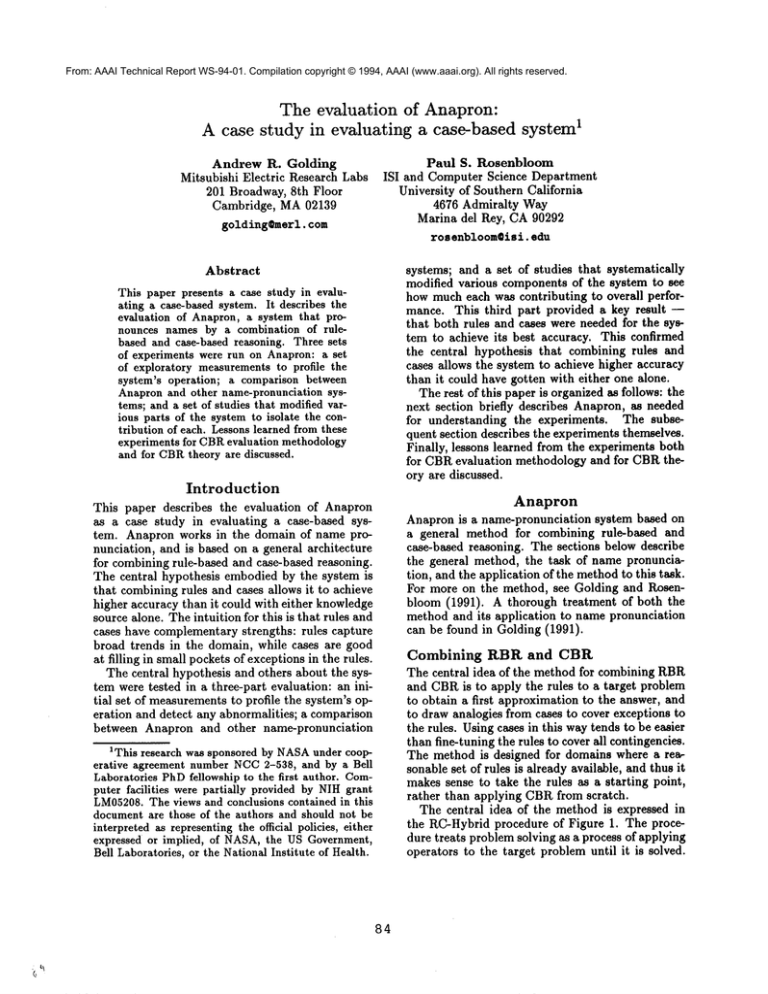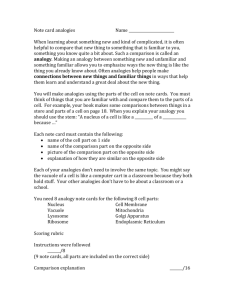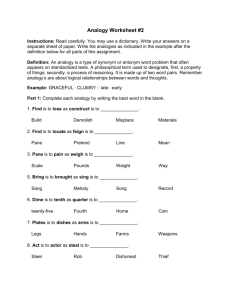
From: AAAI Technical Report WS-94-01. Compilation copyright © 1994, AAAI (www.aaai.org). All rights reserved.
The evaluation
of Anapron:
1A case study in evaluating a case-based
Andrew R. Golding
Mitsubishi Electric Research Labs
201 Broadway, 8th Floor
Cambridge, MA02139
goldingQmerl,
tom
system
Paul S. Rosenbloom
ISI and ComputerScienceDepartment
University
of Southern
California
4676 AdmiraltyWay
Marinadel Rey,CA 90292
rosenbloom@isi,
edu
systems; and a set of studies that systematically
modified various components of the system to see
how mucheach was contributing to overall performance. This third part provided a key result -that both rules and cases were needed for the system to achieve its best accuracy. This confirmed
the central hypothesis that combining rules and
cases allows the system to achieve higher accuracy
than it could have gotten with either one alone.
The rest of this paper is organized as follows: the
next section briefly describes Anapron, as needed
for understanding the experiments. The subsequent section describes the experiments themselves.
Finally, lessons learned from the experiments both
for CBRevaluation methodology and for CBRtheory are discussed.
Abstract
This paper presents a case study in eva]usting s case-based system. It describes the
evaluation of Anapron, s system that pronounces names by a combination of rulebased and case-based reasoning. Three sets
of experiments were run on Anapron: s set
of exploratory measurementsto profile the
system’s operation; a comparison between
Anapron and other name-pronunciation systems; and a set of studies that modified various parts of the system to isolate the contribution of each. Lessons learned from these
experiments for CBRevaluation methodology
and for CBRtheory are discussed.
Introduction
This paper describes the evaluation of Anapron
as a case study in evaluating a case-based system. Anapron works in the domain of name pronunciation, and is based on a general architecture
for combining rule-based and case-based reasoning.
The central hypothesis embodied by the system is
that combining rules and cases allows it to achieve
higher accuracy than it could with either knowledge
source alone. The intuition for this is that rules and
cases have complementary strengths: rules capture
broad trends in the domain, while cases are good
at filling in small pockets of exceptions in the rules.
The central hypothesis and others about the system were tested in a three-part evaluation: an initim set of measurementsto profile the system’s operation and detect any abnormalities; a comparison
between Anapron and other name-pronunciation
1This research was sponsored by NASA
under cooperative agreement number NCC2-538, and by a Bell
Laboratories PhDfellowship to the first author. Computer facilities were partially provided by NIIt grant
LM05208.The views and conclusions contained in this
document are those of the authors and should not be
interpreted as representing the official policies, either
expressed or implied, of NASA,the US Government,
Bell Laboratories, or the National Institute of Health.
84
Anapron
Anapronis a name-pronunciation
systembasedon
a generalmethodfor combiningrule-based
and
case-based
reasoning.
Thesections
belowdescribe
the generalmethod,thetaskof namepronunciation,andtheapplication
ofthemethod
to thistask.
For more on the method,see Goldingand Rosenbloom(1991).A thoroughtreatment
of boththe
methodandits application
to namepronunciation
canbe foundin Golding
(1991).
Combining
RBR. and CBR
The central idea of the method for combining RBR
and CBRis to apply the rules to a target problem
to obtain a first approximation to the answer, and
to draw analogies from cases to cover exceptions to
the rules. Using cases in this way tends to be easier
than fine-tuning the rules to cover all contingencies.
The method is designed for domains where a reasonable set of rules is already available, and thus it
makes sense to take the rules as a starting point,
rather than applying CBRfrom scratch.
The central idea of the method is expressed in
the RC-Hybrid procedure of Figure 1. The procedure treats problem solving as a process of applying
operators to the target problem until it is solved.
Compelling-p(A)
similarity-score(A) _> SS0
and accuracy(A) >_
and (significance(A) >_
or similarity-score(A) )__ SS+)
Procedure RC-hybrid( Problem)
Until Problem is solved do:
(a) KBR:Use the rules to select an operator.
(b) CBR:Look for analogies that contradict
the operator suggested by RBR.
(c) Combination: Decide between the
operators suggested by RBRand CBR.
Figure 2: Compellingness predicate for analogies.
Name pronunciation
Namepronunciation is taken here to be the task of
converting an input spelling (e.g., KEIDEL)into an
output pronunciation (k’ayd*ehl, which rhymes
with MYBELL). The pronunciation is a written
specification of howto pronounce the name; it could
be fed through a speech synthesizer to produce an
actual spoken rendition. A pronunciation includes
the phonetic segments or sounds in the name, as
well as the level of stress to place on each syllable.
Here, the phonetic segments are kaydehl, while "
and " are stress marks. The " says to put secondary stress on kay. The " means primary stress
TM2
on ,dehl. The notation is taken from DECtalk
but is unimportant for purposes of this paper.
In Anapron, the task of name pronunciation is
divided among six principle modules. Table 1
gives a brief account of what each module does,
by way of illustration
for KEIDEL.The language
and morphology modules produce nondeterministic answers; here, the language module generates
two possible language classifications of the name-"Generic" or German. This nondeterminism is carried through the other modules until the selection
module resolves it by choosing the German analysis. The selection modulebases its decision on various rule-based and analogical annotations gathered
in the course of analyzing the name under the different language/morphology analyses.
Figure 1: Top-level procedure for combining rulebased and case-based reasoning.
The procedure applies one operator on each iteration. It chooses the operator in three steps. In the
RBRstep, it selects an operator to apply via the
rules. In the CBRstep, it looks for analogies suggesting operators that contradict the one suggested
by RBR. In the combination step, it decides which
operator to actually apply -- the one suggested by
RBRor the one suggested by CBR.
To decide between RBRand CBRin this last
step, the procedure evaluates the analogy proposed
by CBR.It chooses the CBRoperator if and only if
this analogy is found to be compelling. Compellingness is based partly on the similarity score for the
analogy -- this is the degree of similarity between
the analogical source and target as given by the
similarity metric. It is also based on an empirical verification of the analogy. Empirical verification entails extracting the generalization behind the
analogy and testing it out on other examples in the
case library. There are two results: accuracy, which
is the proportion of examples for which the generalization was found to be correct; and significance,
which is 1 minus the probability of getting that
high an accuracy merely by chance. The analogy
is then said to be compellingiff its similarity score,
accuracy, and significance satisfy the Compelling-p
predicate of Figure 2. The values SSo, SS+, Ao,
and So in the predicate definition are thresholds
that are set by a learning procedure that generates
training analogies for itself from the case library.
Before the RC-hybrid procedure can be run, it is
necessary to create an indexed case library. This is
done in two preprocessing steps. The first, rational
reconstruction (RR), takes as input a set of problem/answer pairs in the domain. For each pair, it
infers the (likely) sequence of operators that were
applied to the given problem to produce the given
answer. The second preprocessing step, predictionbased indexing (PBI), then stores each operator inferred by RRas a positive or negative exemplar of
the rules, according to whether that operator agrees
with the operator predicted by the rules.
Application
of the method
The method for combining RBRand CBR was applied not to the task of name pronunciation as a
whole, but rather to two of its subtasks: transcription and stress assignment. The method requires
two main knowledgesources for each subtask: a set
of rules, and a case library. The rules for transcription and, to a lesser extent, for stress were based on
MITalk (Allen et al. 1987) and introductory grammar texts for French, German, Italian, and Spanish. There are 619 transcription rules and 29 stress
rules. The case library was derived from a pronouncing dictionary of 5000 names. In addition to
2DECtalk is a trademark of Digital
Corporation.
85
Equipment
Module
Language
Morphology
Transcription
Syllable structure
Stress assignment
Selection
Function
Determine language
Identify prefix, root, and
suffix morphemes
Mapletters to phonetic
segments
Break into syllables
Assignlevel of stress to
each syllable
Pick best language/
morphology analysis
Application to KEIDEt,
Generic or German
KEIDEL= a single root morpheme
kiydehl if Generic; kaydehl if German
kiy-dehl if Generic; kay-dehl if German
k" iydehl if Generic; k" ayd’ehl if German
k" ayd’ehl (German)
Table 1: Illustration
of Anapron’s pronunciation modules for KEIDEL.The output of the modules has been
abbreviated for clarity.
these knowledge sources, the method also needs a
similarity metric for comparing pairs of cases. The
metrics for transcription and stress are based on
heuristics about which features of a word determine
a given aspect of its pronunciation; for instance, the
local spelling context around a letter tends to affect its transcription (due to letter grouping and
assimilation effects).
The remainder of this section illustrates how the
method was applied to transcription.
Consider
again the KEIDELexample. In the course of pronouncing this name, Anapron proposes that it is
German, and invokes the transcription module under this analysis. The transcription moduleapplies
a sequence of operators, each of which converts a
string of letters into a string of phonetic segments.
It invokes the RC-Hybrid procedure of Figure 1.
It starts with K, the first letter of the name.3 In
step (a), the rules suggest the K:k operator. This
operator maps the letter K to the phonetic segment
k (as in KITE). No contradictory analogy is found
in step (b). Thus in step (c), the operator
gested by the rules, K:k, is applied. Application of
the next two operators, EI:ay and D:d, is similarly
uneventful, as no contradictory analogies are found.
For the E, things get more interesting.
In
step (a), the rules suggest E:ey, the default pronunciation of E in German (as in FR_EGE).
step (b), an analogy is found from VOGELwhich
suggests the E:eh operator instead. This analogy
has a similarity score of 0.73. Empirical verification
reveals that the generalization behind the analogy
-- which says to apply E:eh in Germannames in a
particular context -- applies to 7 cases in the case
3This exposition is somewhatsimplified. In general,
the transcription rules are applied in multiple parallel
passes, rather than a single, left-to-right pass.
86
library:
ED_ELBROCK,
FOG_EL, GEIBEL, LOGEL,
SCHNABEL,
SPEIDEL, and of course VOGEL.All 7
have S:eh applied. Thus the accuracy of the analogy is 7/7 = 1.00. The significance works out to
be 0.71. The way the thresholds were set, the analogy is deemedcompelling. Thus in step (c), the system selects E:eh, overriding the rules by the analogy
with VOGI~L.
For the final L of the name, the rules suggest L:I,
which again goes unchMlenged. Thus the output of
the transcription module for the Germananalysis
of KEIDEL
is kaydeh]..
Experiments
The sections below describe the three sets of experiments run on Anapron: the exploratory measurements, the system comparison, and the modification studies.
Exploratory
measurements
Exploratory measurements were taken of Anapron
to get a quantitative picture of its operation, and
to detect patterns in its behavior that might signal
problems. For instance, if the system were found
to accept almost all of the analogies that it proposed, this might indicate an overly lax acceptance
criterion. In fact, the main result of the exploratory
measurements was that the system was being overly
strict about accepting analogies. This was shown
by an abundance of errors of analogical omission
4compared to errors of analogical commission.
4This could be fixed by lowering the system’s SS0
threshold, thereby relaxing the acceptancecriterion, or
by re-workingthe similarity metrics to allow better discrimination between good and bad analogies.
The next section describes the test set for this
experiment. The subsequent two sections give
overviews of the particular measurements made,
grouped according to whether they were objective,
or included a subjective component.
Test set The test set for this and the other experiments was drawn from the Donnelley corpus,
a database of over 1.5 million distinct surnames
covering 72 million households in the US. Names
in Donnelley range from extremely common(e.g.,
SMITH,which occurs in over 670,000 households) to
extremely
rare(e.g.,BOURIMAVONG,
whichoccurs
in 1 household).
The numberof households
that
havea particular
namewillbe referred
to as the
frequency (of occurrence) of the name.
Test sets were constructed from Donnelley by selecting points of interest along the frequency spectrum, and randomly sampling an appropriate number of namesat each point. 5 The test set for the objective measurements contained 13 exponentiallydistributed frequencies: 1, 2, 4, 8, ..., 4096.
The frequencies were distributed exponentially because this yields evenly-spaced measurements of
Anapron’s behavior -- this was determined in a
pilot study, which showed that Anapron’s percentage of acceptable pronunciations drops linearly as
frequency is decreased exponentially. The test set
contained a total of 10,000 names, with between
250 and 1000 at each frequency. These numbers
represent a tradeoff between the cost of running the
test, and the size of the confidence intervals in the
resulting measurements. The names were chosen to
be disjoint from Anapron’s dictionary, since names
pronounceable by rote lookup are unrepresentative
of system behavior.
measurements was an effect termed the analogical
decline. It says that as name frequency decreases,
the number of highly plausible analogies 6 to the
name also decreases; however, the overall number
of analogies (highly plausible or otherwise) does not
decrease significantly. This asymmetric decrease in
analogical activity is investigated further in Golding (1991).
Subjective
measurements
Subjective
measurements of the system’s behavior were made not
on the 10,000-name test set described above, but on
a scaled-down 1,000-name version. This was necessary to make it feasible to obtain humanjudgements. The 1,000-name test set had 250 names
at each of four (roughly) exponentially-distributed
frequencies: 1, 32,256, and 2048.
The subjective measurements consisted of judgements, for each name, about the acceptability of the
following: the overall pronunciation, the individual transcription and stress operators applied, the
choice of language/morphology analysis, and the
analogies proposed (whether accepted or rejected).
The judgements were made by the first author. To
facilitate this rather laborious process, a judgement
editor was used, which provided a graphical user interface for entering or changing judgements about a
name. The editor also verified that the judgements
for a name were complete and consistent.
The main result of the subjective measurements
was that errors of analogical omission were found
to be far more numerous than errors of analogical commission. This suggests that the system’s
analogical acceptance criterion may have been too
conservative.
System comparison
To see how the combined RBR/CBRapproach performs relative to other methods, Anapron was compared with seven other name-pronunciation systems: three state-of-the-art
commercial systems
(from Bellcore, Bell Labs, and DEC), two versions
of a machine-learning system (NETtalkT), and two
humans. The sections below describe the test set,
design, and analysis of the experiment. For a fuller
presentation, see Golding and Rosenbloom (1993).
Objective
measurements Objective
measurements were made for both the rule-based and casebased parts of the system. The rule-based measurements counted how many operators were applied by
each module (language, morphology, transcription,
syllable structure, and stress assignment). The
case-based measurements counted how many analogies were proposed, accepted, and rejected, and for
what reason (where the reason corresponds to the
way the compellingness predicate matched or failed
to match the analogy). All measurements were broken down by name frequency, to see how the system’s behavior changes as the names get rarer and
thus more difficult to pronounce.
The main unexpected finding from the objective
Test set The test set for the system comparison
was similar to that used in the subjective measurements, except that: (1) only 100 names (not 250)
SAhighly plausible analogy is one whosesimilarity
score is SS+or greater.
ZThetwo versions of NETtalkwill be referred to as
BP-legal and BP-block. BP-legal is vanilla NETtalk;
BP-blockis NETtalkenhancedwith a "block decoding"
postprocessor (Dietterich et al. 1990).
5If Donnelley had fewer than the desired number
of names at some frequency f, then the names were
selected randomly from the narrowest symmetric frequency band around f that was big enough.
87
System
Ubound
Humanl
Human2
Comml
Comm2
Comm3
Anapron
BP-block
BP-legal
Name frequency
2048 256 32
98
98
98
97
93
93
98
94
94
97
95
93
96
90
87
94
96
89
91
88
85
84
83
77
78
72
66
1
96
88
86
90
86
78
80
69
52
System
Humanl
Human2
Comml
Comm2
Comm3
BP-block
BP-legal
Overall
97
93
93
93
90
89
86
78
67
Name frequency
2048
256 32
+
+
+
+
+
+
+
+
+
+?
+
+?
+
+
+
1
+
+
+
+
-?
Overall
+
+
+
+
+
Table 3: Differences in performance between other
systems and Anapron, broken down by name frequency. A plus sign (+) means higher acceptability
than Anapron; a minus sign (-) means lower acceptability. All differences are significant at the 0.01
level, except those marked with a question mark
(?), which are not significant even at the 0.10 level.
Table 2: Percentage of acceptable scores for each
system, broken down by name frequency.
were chosen at each frequency, to reduce the burden on the human test subjects; and (2) the test
set was no longer constrained to be disjoint from
Anapron’s dictionary, as an unbiased measurement
of system performance includes names both in and
out of the dictionary.
Table 2 shows that Anapron performs almost
at the level of the commercial systems, and substantially better than the two versions of NETtalk.
Also, although the eight systems seem to hit a performance asymptote at 93%, the Ubound system
demonstrates that it is possible to score at least
97%. This suggests that there is room for improvement in all systems.
To detect whether the differences
between
Anapron and the other systems were statistically
significant,
an ANOVA
was run, followed up by a
Bonferroni multiple comparison procedure. Table 3
gives the results. It shows that overall, Anapron
outperformed the two versions of NETtalk, but the
commercial systems and humans did better than
Anapron. However, in some frequency ranges, a
significant difference between Anapronand certain
commercial systems could not be detected.
Design The first step of the experiment was to
run each system on the 400-nametest set. The output of the computer systems was gathered in the
form of written pronunciations (before they were
sent to a speech synthesizer). The output of the humans was tape-recorded and transcribed as written
pronunciations. In the case of NETtalk, the system also needed to be trained; this was done using
Anapron’s 5000-name pronouncing dictionary.
A cassette tape was then made of the pronunciations. To hide the identities of the systems, all pronunciations were read by the DECtalk speech synthesizer. For each name, duplicate pronunciations
were eliminated, and the remaining pronunciations
were permuted randomly. The order of names was
permuted randomly as well. A set of 14 human
subjects listened to the cassette tape and rated the
acceptability of each pronunciation.
Modification
studies
To gauge the contribution
of Anapron’s components to its overall performance, a set of experiments were performed that modified the components and observed the effects on system performance. There were five such studies, modifying: rules and cases, thresholds,
language
knowledge, morphology knowledge, and syllablestructure knowledge. The first study -- on rules
and cases -- addressed the central hypothesis of
the system concerning the efficacy of combining
rules and cases. It showed that the system achieved
higher accuracy by combining the two than it could
have achieved with either one alone. The threshold study tested how sensitive the system’s performance was to the threshold settings used in the
definition of analogical compellingness -- i.e., SSo,
Analysis The main results of the system comparison appear in Table 2. s It gives the percentage
of acceptable scores for each system, broken down
by name frequency. The table includes an imaginary ninth system, labelled Ubound, which generates for each name the pronunciation that received
the greatest number of acceptable votes from the
judges. It measures the degree to which all judges
can be pleased simultaneously, using just the pronunciations available from the eight systems tested.
SThe names of the commercial systems and humans
have been omitted since this paper is concerned with
evaluation methodologyrather than the results per se.
88
SS+, A0, and So (see Figure 2). Extreme raising
or lowering of any one threshold at a time was generally found to hurt accuracy, although lowering of
SS0 sometimes improved accuracy at the expense
of increasing run time. The remaining three studies concerned the system’s support knowledge -i.e., knowledge needed in service of the two toplevel tasks, transcription and stress. Degrading
the language or morphology knowledge sufficiently
was found to have a substantial negative impact on
system accuracy, while degrading syllable-structure
knowledgehad a relatively minor effect.
The sections below focus on the first of these experiments -- the rule/case study. They discuss the
test set, design, and analysis of the study.
Rule
strength
0
1/3
2/3
1
0 1000
19 27
33 39
46
54
56
65
Case strength
2000 3000 4000
34
35
32
46
43
44
57
56
56
67
67
65
5000
36
47
59
68
Table 4: System accuracy results. Each value is the
percentage of names in the test set for which the
system produced an acceptable pronunciation.
The cases were set to six strengths: 0, 1000, 2000,
3000, 4000, and 5000. The strength is just the number of names that were kept in the case library.
Again, each weakening of the case library produces
an arbitrary subset of the previous ease library.
Test set Like the system comparison,
the
rule/case experiment required a great deal of human effort in the evaluation. The test set was
therefore made the same size as in the system comparison -- 100 names at each of four frequencies.
The only difference was that, as in the exploratory
measurements, the test set was constrained to be
disjoint from Anapron’s dictionary, since again rote
lookup behaviors were not of interest.
Analysis Although accuracy and run-time data
were both collected, only the accuracy results will
be reported here. For the run-time results, see
Golding and Rosenbloom (1991).
Table 4 shows system accuracy as a function of
both rule strength and case strength. The main
result is that accuracy improves monotonically as
rule or case strength increases. The total improvement in accuracy due to adding rules is between
32% and 38% of the test set (depending on ease
strength).
For cases it is between 12% and 17%
(depending on rule strength). This substantiates
the central hypothesis about the system -- that by
combining rules and cases, it can achieve a higher
accuracy than it could with either one alone.
Design The rule/case study involved independently varying the strength of the system’s rules
and cases. For each combination of rule strength
and ease strength, the system was run on the 400name test set, and its accuracy and run time were
recorded. Accuracy was measured as the proportion of acceptable pronunciations generated by the
system, where acceptability was judged by the first
author. 9 All judgements were cached and re-used
if a pronunciation recurred, to help enforce consistency across trials.
The rules were set to four different strengths: 0,
1/3, 2/3, and 1. A strength of 1 means all transcription and stress rules were retained in the system. Strength 0 means that all ruleS were deleted
except default rules. The default rules transcribe
a letter or assign stress if no other more specific
rule matches. The default rules cannot be deleted,
otherwise the system would be unable to generate
a complete pronunciation
for some names. Retaining the default rules corresponds to keeping
137 out of 619 transcription rules and 16 out of 29
stress rules. As for rule strengths between 0 and 1,
these correspond to retaining a proportional number of non-default rules in the system. Each
strength is obtained by deleting a randomsubset of
the non-default rules from the next higher strength.
Lessons
Learned
Two kinds of lessons emerge from the evaluation presented here: lessons for CBRevaluation
methodology, and lessons for CBRtheory. These
are discussed below, together with issues that arose
in designing the evaluation.
Lessons for CBR evaluation
methodology
The work presented here suggests a three-part evaluation methodology: (i) Profile the operation of the
system to check for unexpected behaviors; (ii)
a system comparison to gauge the overall performance of the system -- this provides at least indirect evidence that the methods under investigation
are sound, in that they lead to high performance;
and (iii) Run modification studies to understand
the contribution made by each part of the system.
Expressed at this abstract level, this evaluation
methodology applies not only to CBR, hut to a
wide range of computer systems. The instantiation
to Anapron showed more about how to evaluate
9Thefirst author was an unusually harsh judge, thus
the scores here are not directly comparableto those of
the system comparison.
89
CBRsystems in particular. For instance, part (i)
of Anapron’s evaluation counted errors of analogical omission and commission, a measure that is
relevant for most case-based systems. In part (iii)
of Anapron’s evaluation, the first experiment broke
down the system into fairly coarse components:
RBR and CBR. This was because the main hypothesis concerned these components. The same
methodologycould be applied just as well to lowerlevel components, such as retrieval or adaptation,
if these are the componentsof interest.
Lessons for CBR theory The first
lesson
learned from the Anapron experiments for CBR
theory is that the accuracy of CBRsystems can be
improved by combination with RBR. This comes
directly from the confirmation of the main hypothesis about the system.
A second lesson is that the compellingness predicate (and associated empirical verification) gives
the system the ability to weed out bad analogies.
This is an important ability for any CBRsystem
that has the potential to draw incorrect analogies.
The effectiveness of the compellingness predicate
was demonstrated in part (iii) of the experiments,
which showed that substantial tampering with even
a single compellingness threshold at a time generally hurt system accuracy.
A third lesson is that the introduction of RBR
provides a convenient and natural way to index cases: prediction-based indexing. While PBI
was not directly tested in the experiments, indirect evidence for its success comes from part (ii),
which showed that the system, using this indexing
method, achieves very high performance. An additional benefit of PBI, not measured in the experiments, is in saving development time -- it frees the
system designer from having to analyze the domain,
identify a good indexing vocabulary, devise appropriate computed features, and so on. Instead, PBI
exploits the structure of the domainthat is implicit
in the rules and thus already available.
A fourth lesson for CBRtheory is that rational
reconstruction affords a novel method of case adaptation. Traditional adaptation techniques do some
kind of repair to make the source and target cases
compatible. The approach in Anapron is to use
RR. to break downa source case into the individual
operators that were applied to solve it. These individual operators are then fine-grained enough to
be transferred verbatim from source to target. This
can be thought of as "adaptation by factoring into
operators". As with PBI, the experiments reported
here do not directly showthe benefits of this adaptation strategy, but the system comparison shows
that it leads to high overall performance.
9O
Design issues In designing the Anapron experiments, a few issues arose both for evaluating systerns in general, and for evaluating CBRsystems
in particular. The main general issue was obtaining the various forms of knowledge needed to run
the experiments: a test set; humanjudgements of
each system’s answers to the test set; and, in certain
cases, auxiliary knowledgebases, such as an aligned
dictionary of names and their pronunciations for
training NETtalk. System evaluations would be
greatly facilitated if this sort of knowledgewere already commonlyavailable. Shared datasets, such
as the U.C. Irvine Repository of Machine Learning, are a good start in this direction, but more
effort is still needed.
TwoCBR-specific issues arose in Anapron’s evaluation, and remain open problems. First, it would
be desirable to run a modification experiment on
the similarity metric; however, it is not obvious how
to characterize the space of possible similarity metrics. Second, while it is relatively straightforward
to count errors of analogical commission (harmful
analogies), it is harder to detect all errors of analogical omission (helpful analogies that were missed).
Acknowledgements
We would like to thank Mark Liberman, Cecil
Coker, Murray Spiegel, Tony Vitale, Tom Dietterich,
John Laird, Connie Burton, and David
Shapiro for their help with the system comparison.
Weare also indebted to Murray Spiegel for arranging for us to borrow a pronouncing dictionary of
names from Bellcore.
References
J. Allen, M. S. Hunnicutt, and D. Klatt. From
Text to Speech: The MITalk System. Cambridge
University Press, Cambridge, 1987.
T. G. Dietterich, H. Hild, and G. Bakiri. A comparative study of ID3 and backpropagation for
English text-to-speech mapping. In Proceedings
of 7th IMLW, Austin, 1990. Morgan Kaufmann.
A. R. Golding. Pronouncing Names by a Combination of Rule-Based and Case-Based Reasoning.
PhDthesis, Stanford University, 1991.
A. R. Golding and P. S. Rosenbloom. Improving
rule-based systems through case-based reasoning.
In Proceedings of AAAI-91, Anaheim, 1991.
A. R. Golding and P. S. Rosenbloom. A comparison
of Anapron with seven other name-pronunciation
systems. Journal of the American Voice Input/Output Society, 14, 1993.






